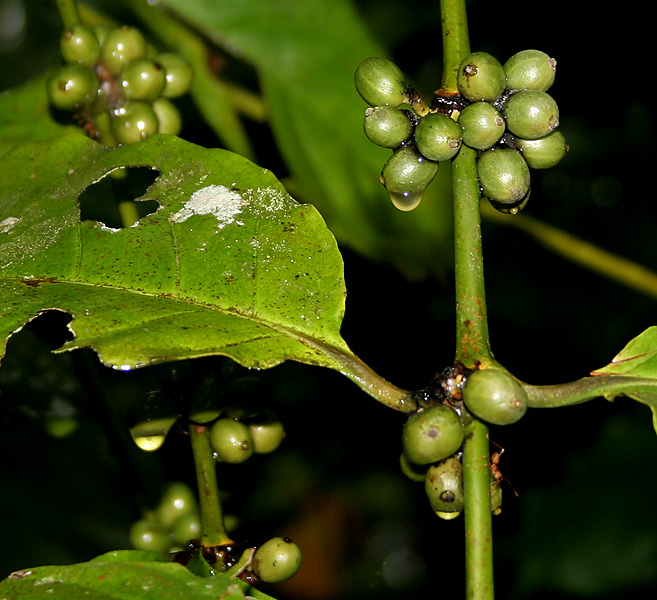Metaparasitylenchus Hypothenemi on:
[Wikipedia]
[Google]
[Amazon]
''Metaparasitylenchus hypothenemi'' (Nematoda: Allantonematidae) is a free-living nematode parasite that infects coffee berry borers (''Hypothenemus hampei''), small beetles that harm coffee crops worldwide. This nematode has been shown to interfere with the parasitic activity of the coffee berry borer by increasing the mortality of its progeny.Jaramillo J, Borgemeister C, Baker P (2006) Coffee berry borer ''Hypothenemus hampei'' (Coleoptera: Curculionidae): searching for sustainable control strategies. Bulletin of Entomological Research 96:223-233

 In order to alleviate the economic burden the coffee berry borer has on the coffee cash crop, parasitoids of the borer have been used. Most notably Bethylid parasitoids, Eulophyd parasitoids (
In order to alleviate the economic burden the coffee berry borer has on the coffee cash crop, parasitoids of the borer have been used. Most notably Bethylid parasitoids, Eulophyd parasitoids (
Geographical distribution
''M. hypothenemi'' has only been identified in coffee plantations inChiapas
Chiapas (; Tzotzil language, Tzotzil and Tzeltal language, Tzeltal: ''Chyapas'' ), officially the Free and Sovereign State of Chiapas ( es, Estado Libre y Soberano de Chiapas), is one of the states that make up the Political divisions of Mexico, ...
, Mexico
Mexico (Spanish: México), officially the United Mexican States, is a country in the southern portion of North America. It is bordered to the north by the United States; to the south and west by the Pacific Ocean; to the southeast by Guatema ...
and Honduras
Honduras, officially the Republic of Honduras, is a country in Central America. The republic of Honduras is bordered to the west by Guatemala, to the southwest by El Salvador, to the southeast by Nicaragua, to the south by the Pacific Oce ...
.Poinar, G., Vega, F., Castillo, A., and Infante, F. (2004). METAPARASITYLENCHUS HYPOTHENEMI N. SP. (NEMATODA: ALLANTONEMATIDAE), A PARASITE OF THE COFFEE BERRY BORER, HYPOTHENEMUS HAMPEI (CURCULIONIDAE: SCOLYTINAE). J. Parasitol. 90: 1106-1110 Its only known host is the coffee berry borer (''Hypothenemus hampei''), which is originally native to Angola
, national_anthem = " Angola Avante"()
, image_map =
, map_caption =
, capital = Luanda
, religion =
, religion_year = 2020
, religion_ref =
, coordina ...
, Africa
Africa is the world's second-largest and second-most populous continent, after Asia in both cases. At about 30.3 million km2 (11.7 million square miles) including adjacent islands, it covers 6% of Earth's total surface area ...
. This raises the question of whether ''M. hypothenemi'' was brought over to the New World with the coffee berry borer or if it is native to Mexico and Central America and only found the coffee berry borer as a host when it was brought to the New World.
Biocontrol agent
 In order to alleviate the economic burden the coffee berry borer has on the coffee cash crop, parasitoids of the borer have been used. Most notably Bethylid parasitoids, Eulophyd parasitoids (
In order to alleviate the economic burden the coffee berry borer has on the coffee cash crop, parasitoids of the borer have been used. Most notably Bethylid parasitoids, Eulophyd parasitoids (Eulophidae
The Eulophidae are a large family of hymenopteran insects, with over 4,300 described species in some 300 genera. The family includes the genus ''Elasmus'', which used to be treated as a separate family, "Elasmidae", and is now treated as a subf ...
), and Braconid parasitoids (Braconidae
The Braconidae are a family of parasitoid wasps. After the closely related Ichneumonidae, braconids make up the second-largest family in the order Hymenoptera, with about 17,000 recognized species and many thousands more undescribed. One analysis ...
) have been introduced in an attempt to reduce the beetle’s efficacy in destroying coffee plants. However, while these parasitoids improve the situation, they are not successful in eliminating the economic damage. Additionally, evidence suggests that the beetle is capable of developing resistance against the common pesticide endosulfan
Endosulfan is an off-patent organochlorine insecticide and acaricide that is being phased out globally. It became a highly controversial agrichemical due to its acute toxicity, potential for bioaccumulation, and role as an endocrine disruptor. ...
.Brun, L., Marcillaud, C., Gaudichon, V. and Suckling, D. (1989). Endosulfan Resistance in Hypothenemus hampei (Coleoptera: Scolytidae) in New Caledonia. Journal of Economic Entomology, 82: 1311–1316 Therefore, use of ''Metaparasitylenchus hypothenemi'' to induce disease in borer populations has been considered.
It is prudent to explore such a course of action because use of the ''Metaparasitylenchus hypothenemi'' nematodes provides a method with which to sterilize female borers. Depending on how many parasitic females are present, sterilization can range from being partially derailed to being completely shut down. Though sterilization fails to ward off a current generation of infection, by arresting the reproductive capabilities of these beetles the worm will ultimately curtail beetle infestation.
Loss of reproductive capabilities through ''Metaparasitylenchus hypothenemi'' parasitization is tied to the lifecycle of the nematode. Mature parasitic females are carried through the beetle’s lifecycle. During this time, eggs hatch within the female and proceed through to stage J3 (see Lifecycle) and at this point are ready to exit the host beetle. Exit occurs through the GI tract or the reproductive tract and expulsion involves arrest of the beetle’s own reproductive capabilities.
See also
*''Howardula aoronymphium
''Howardula aoronymphium'' is a species of nematode that infects specialist mushroom-feeding fruit flies such as ''Drosophila falleni'' and ''Drosophila neotestacea''. Mated female nematodes pierce the fly larva cuticle and take up residence in th ...
''
*Allantonematidae
Allantonematidae is a family of insect-parasitic nematodes from the order Tylenchida. Allantonematid nematodes infect a variety of insects including beetles, butterflies, flies, thrips, ants, and more. For instance, the nematode ''Howardula aoron ...
References
{{Taxonbar, from=Q6823089 Tylenchida Nematodes described in 2004